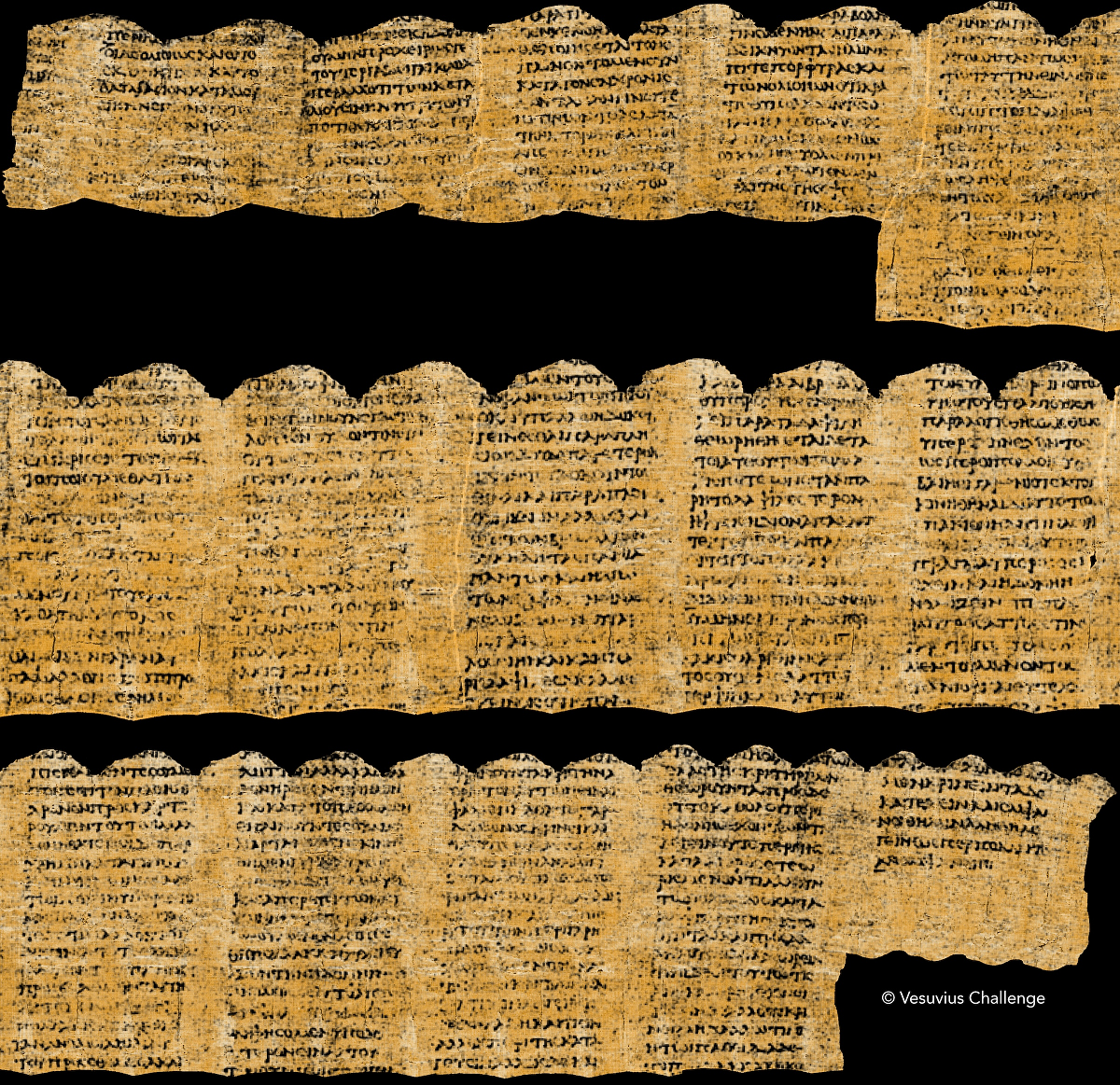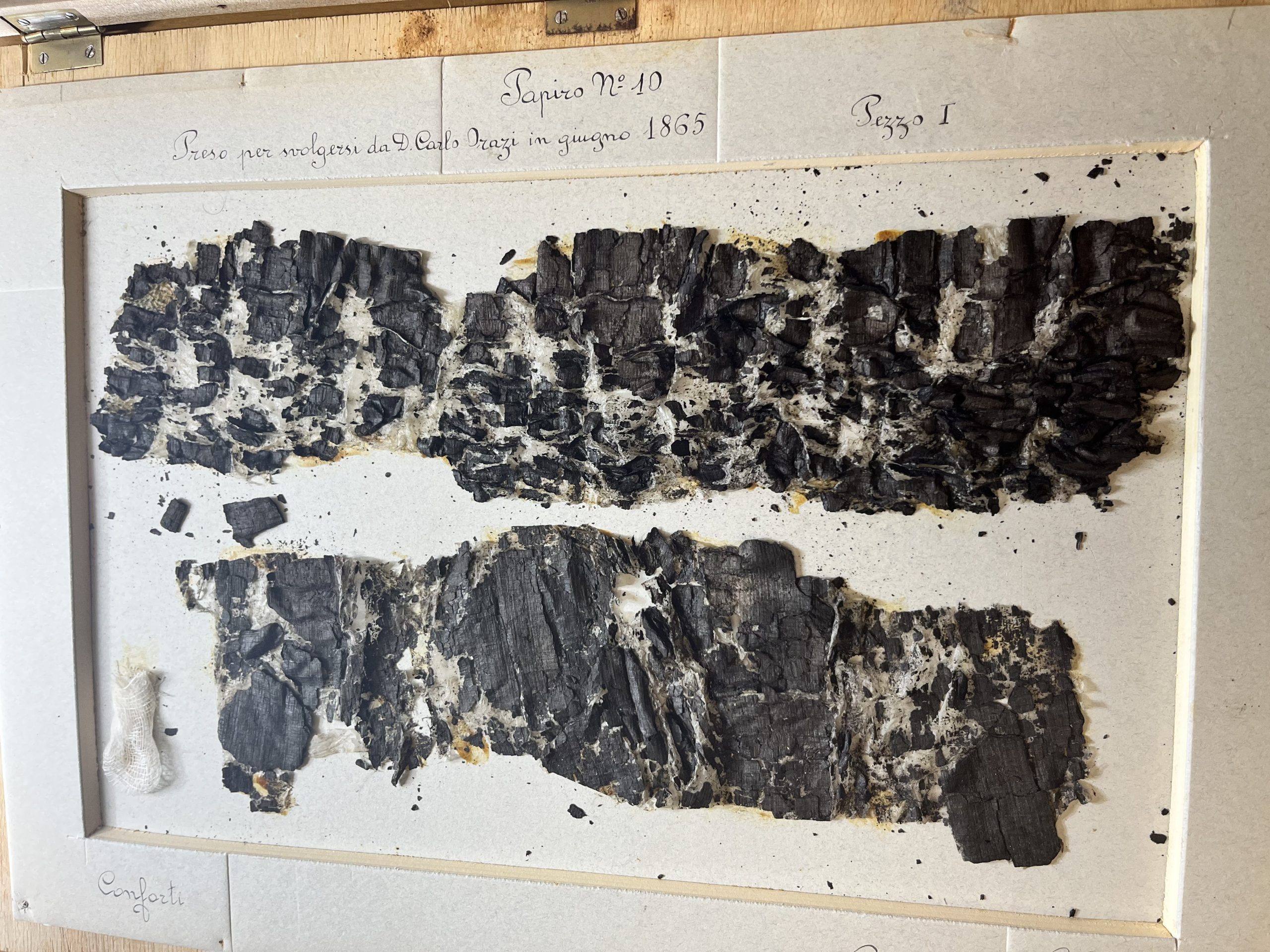Herculaneum Papyri talking from the ashes
Author: Juan F. Trillo, PhD in Linguistics and Philosophy (U. Autónoma de Madrid), PhD in Literary Studies (U. Complutense de Madrid).
Ashes have always been a powerful and evocative metaphor representing a vanished and irretrievable past. However, we live in prodigious times, in which nothing can be taken for granted anymore, and the feat of reading the contents of some of the charred papyri of Herculaneum is a good example of this. The credit goes to the winners of the Vesuvius Challenge Grand Prize 2023, which, according to its rules, would award 700,000 dollars to whoever manages to recover at least 85% of 4 papyrus fragments with 140 characters each. The winners, the team formed by Youssef Nader (Egyptian biorobotics student in Berlin), Luke Farritor (robotics student at the University of Nebraska) and Julian Schillinger (robotics student at EHT Zurich), were able to exceed the competition rules by far, providing, in total, more than 2,000 readable characters.

The organizers themselves were surprised, as they estimated the chances of someone winning the prize in 2023 at only 30%. On the one hand, not even a single letter had been identified inside the scrolls and, on the other, the scrolls had barely begun to be segmented, all of which made it really difficult to qualify for the prize on offer, at least within the established dates. The organizers highly value the combination of cooperation and competition between the different teams of researchers, as without the former it would have been difficult to achieve the results that the latter has produced. As an incentive for this cooperation, small prizes (between 1,000 and 10,000 dollars) were established every two months for those who contributed with open codes applicable to the reading of the texts or who made the results of their research available to the entire community.
Founded between the 7th and 6th century BC, the city of Herculaneum, along with Pompeii, was buried in 79 AD under a layer of ash and pyroclastic material, sediments that later became a mass of volcanic tuff, similar to solid rock. The extremely high temperature of these volcanic materials and the speed with which they covered the entire city meant that the combustion process preserved in their original form many objects and even the corpses of those who were unable to flee the city.
The discovery of the ruins of Herculaneum took place around the middle of the 18th century and with it, the remains of what had been a magnificent villa, owned by Lucius Calpurnius Pison Caesoninus, the stepfather of Julius Caesar, came to light. Years later, the largest library of antiquity recovered to date, consisting of almost 2,000 papyrus scrolls, was found inside, which is why it has been known ever since as the Villa of the Papyri. So far it is known that most of them are written in Greek and that most, if not all, were the work of the Epicurean poet and philosopher Philodemus of Gadara, a disciple of Zeno and teacher of Virgil. His few known works are highly prized, both for their historical and literary value, and recovering the texts from the Villa of the Papyri will help to complete an epoch of the classical period from which very few documents have survived. The problem is that all these scrolls are charred, almost unrecognizable, so much so that many were initially discarded because they were mistaken for fragments of burnt branches. However, once they became aware of their nature, efforts to make them legible have been numerous and the techniques employed have been diverse.

The first attempts to unroll them caused the papyri to disintegrate into small pieces, despite the inventiveness of certain mechanisms, such as that of the abbot Antonio Piaggio towards the end of the 18th century, or the chemical methods employed in the 19th century by the Briton Humphry Davy. Later, the procedures were refined and by the middle of the 20th century almost 600 manuscripts had been unrolled in their entirety, although fewer than 150 had been deciphered. Again, the fact that the texts were written in black ink and that they now appeared on a black support —the charred papyri— made it almost impossible to distinguish them with the naked eye. However, thanks to technological advances in the early 21st century, multispectral imaging techniques began to be used and the 1,600 papyri that remained unrolled were digitized. A new approach, virtual unrolling, was then proposed, using X-ray phase-contrast tomography (XPCT), and later, around 2018, with the help of the Diamond Light Source particle accelerator (Harwell Science and Innovation Campus, UK) small traces of ink made with lead were detected in unrolled papyri, but without being able to identify any letters. Finally, in 2023, computer scientists and technology CEOs Nat Friedman, Daniel Gross and Brent Seales launched the Vesuvius Challenge with high prizes to encourage researchers worldwide. The competition organizers made the images of the scrolls from the scanning with the particle accelerator available to participants.
The result was announced last February, designating the winning team and assigning USD50,000 to each of the other three finalist teams. The members of the winning team had all previously made significant contributions to the study of the papyri: Luke Farritor and Youssef Nader had come first and second in a previous competition —First Letters Prize; USD40,000 and USD10,000 respectively, to whoever could read at least 10 letters in a 4 cm area of an unrolled papyrus— while Julian Schillinger had won three prizes for providing tools to enable effective segmentation of the papyri. As the contestants were working on the same 3D mapped papyrus segments provided by the organization, the team of Farritor, Youssef and Schillinger in turn provided three different models that complemented each other and have resulted in the best images of the same areas of the papyri achieved so far. On the other hand, this redundancy has served to prevent erroneous results —”hallucinations”— from the AI (machine learning models) employed. The identification and ink-reading codes have been made openly available for the benefit of the entire research community. In addition, Schillinger has upgrade his previous contributions by including in the work a new fragment segmentation code —ThaumatoAnakalyptor— that significantly improves on everything that has been used to date.
And as for the content of the text fragments that have been read so far, it coincides with what was expected: philosophical reflections related to the Epicurean school, to which Philodemus belonged, on whether those goods that are scarce or those that are abundant provide more pleasure. Scholars consider it very likely that, in about the 90% of text that remains to be recovered, the philosopher compares pleasure from different sources, such as music or food and drink.
To bring back to life, so to speak, and to “listen” to those long gone has always been a persistent human longing. Who knows how far we will go in our attempt to faithfully reconstruct past events, but if we have been able to make the ashes speak, there is reason for being optimistic.
Further reading:
“Analysis Of Herculaneum Papyri With X-ray Computed Tomography”, by J. Griffioen, R. Baumann and M. Field. S2CID: 7667891.
“Investigating Herculaneum Papyri: An innovative 3D approach for the virtual unfolding of the rolls”, by I. Bukreeva, M. Alessandrelli, V. Formoso, G. Ranocchia and A. Cedola. arXiv:1706.09883
2 comments
[…] Si hemos podido leer cenizas de 2000 años de antigüedad, ¿qué será lo próximo? Para conocer más al respecto, en Mapping Ignorance Journal. […]
This is the best article on the Herculaneum scrolls published over the last months, of those flooding the internet with little to no reference to history of the scrolls or previous attempts at translation.